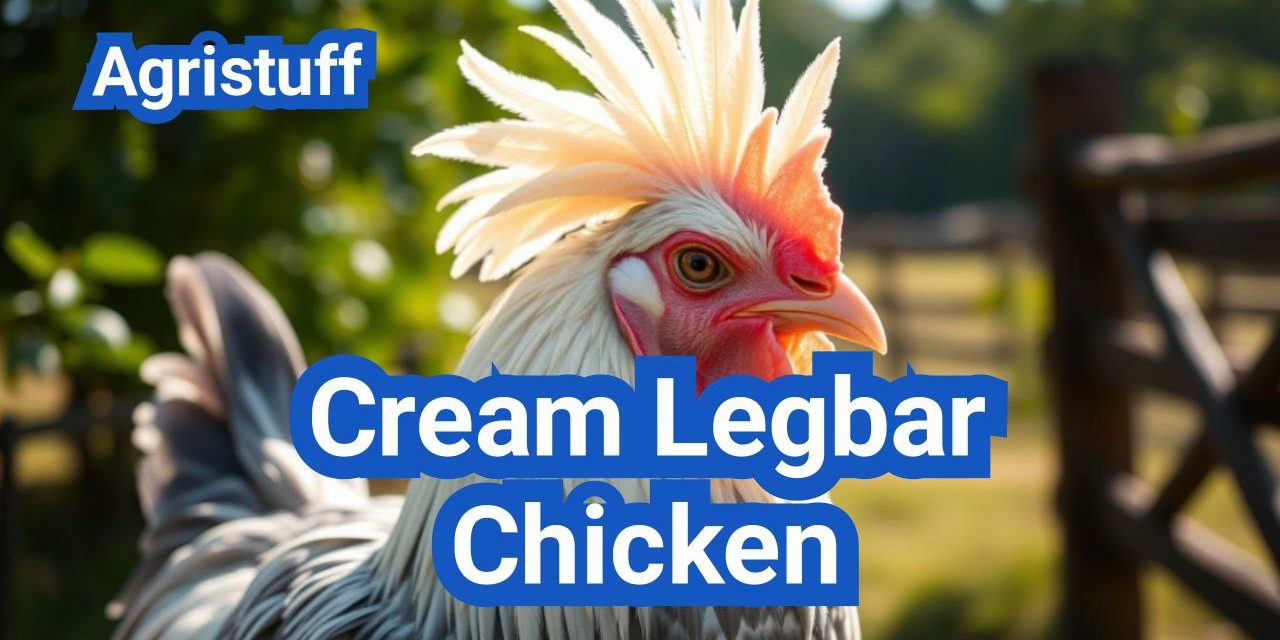The Cream Legbar Chicken is a unique and fascinating breed, known for its striking appearance and impressive egg-laying abilities. Originating in the early 20th century, this breed has gained popularity among backyard chicken keepers due to its friendly temperament and high egg production.
One of the most distinctive features of the Cream Legbar is its ability to lay blue or green eggs, a trait that sets it apart from other breeds. With a moderate size and an energetic yet friendly disposition, the Cream Legbar makes an excellent addition to any flock.
Key Takeaways
- Egg-laying breed known for blue or green eggs
- Friendly and energetic temperament
- Moderate size, suitable for backyard flocks
- High egg production rate
- Unique appearance
The History and Origin of Cream Legbar Chickens
With roots tracing back to Cambridge University in the 1930s, the Cream Legbar chicken has become a notable auto-sexing breed. The development of this breed is a testament to the advancements in poultry breeding during the early 20th century.
Development in Great Britain
The Cream Legbar breed was developed in Great Britain, specifically at Cambridge University, where scientists and breeders worked together to create a chicken that was not only prolific in egg laying but also had the unique characteristic of being auto-sexing. This means that the sex of the chicks could be determined from birth, a trait that was highly valued by breeders. The auto-sexing capability was achieved by crossing Barred Plymouth Rock roosters with Gold Campine hens, laying the foundation for the Cream Legbar’s genetic background.
Genetic Background and Breeding
The genetic background of Cream Legbar chickens is complex, involving several breeds to achieve the desired traits. The breed was developed to be a hardy, prolific layer with a friendly disposition. According to poultry breeding experts, “The Cream Legbar’s ability to lay a significant number of blue eggs, combined with its auto-sexing trait, made it an instant success among backyard chicken keepers and commercial breeders alike.”
“The introduction of the Cream Legbar breed revolutionized backyard chicken keeping by providing a breed that was both aesthetically pleasing and productive.”
The breeding program at Cambridge University was meticulous, involving careful selection and cross-breeding to enhance the breed’s characteristics. The result was a chicken that not only laid a considerable number of eggs but also had a unique appearance, with its cream-colored plumage and crest.
Physical Characteristics of Cream Legbar Chickens

With their crested heads and varied plumage, Cream Legbars are a visually appealing breed. Their unique appearance is one of the reasons they have gained popularity among backyard chicken keepers and poultry enthusiasts.
Size and Weight
Cream Legbar chickens are known for their medium size. Roosters typically weigh between 7-9 pounds, while hens weigh around 5-7 pounds. This moderate size makes them manageable for many backyard flocks.
| Gender | Weight Range (lbs) |
|---|---|
| Rooster | 7-9 |
| Hen | 5-7 |
Distinctive Crest and Appearance
One of the most distinctive features of Cream Legbar chickens is their crest. The crest is a tuft of feathers on top of the head, which gives them a unique and somewhat comical appearance. Their crested heads are a hallmark of the breed and add to their visual appeal.
Color Varieties
Cream Legbar chickens come in several color varieties, including cream, gold, and silver. The cream color variety is particularly popular, with its soft, creamy plumage. The breed’s varied colors add to their attractiveness and make them a favorite among those who appreciate diverse poultry.
The Cream Legbar’s physical characteristics, including their size, crest, and color, make them a standout breed. Their attractive appearance and robust health contribute to their popularity.
Understanding the Cream Legbar Chicken Breed
One of the most significant advantages of raising Cream Legbars is their auto-sexing capability, which simplifies the process of determining the sex of the chickens. This characteristic is particularly valuable for breeders and backyard chicken keepers alike.
Auto-sexing Capabilities
The Cream Legbar breed is known for its auto-sexing trait, which allows for the easy identification of male and female chicks based on their down color and feather patterns. This is made possible through careful breeding practices that link specific genetic markers to the sex of the chicks.
Auto-sexing in Cream Legbars is a result of genetic research and selective breeding. It enables breeders to sex chicks accurately from a young age, reducing the need for invasive sexing methods.
Cream Legbar Pullet vs Cockerel Identification
Identifying whether a Cream Legbar chick is a pullet (female) or a cockerel (male) can be done by observing the chick’s down color and feathering patterns. Generally, male Cream Legbar chicks have distinct markings that differentiate them from females.
| Characteristic | Male (Cockerel) | Female (Pullet) |
|---|---|---|
| Down Color | Typically lighter with distinct head spots | Often darker with less distinct head spots |
| Feather Development | Usually develops primary flight feathers earlier | Develops feathers at a more uniform rate |
By understanding these differences, breeders can accurately sex their Cream Legbar chicks, making it easier to manage their flock.
Temperament and Behavior
Cream Legbar chickens are renowned for their friendly and inquisitive nature, making them a delightful addition to any backyard flock. Their temperament is one of the key reasons they are gaining popularity among chicken keepers.
Personality Traits
The Cream Legbar breed is known for its exceptional friendliness and curiosity. They are active birds that enjoy exploring their surroundings and interacting with their human caregivers. This breed is particularly noted for being quite docile, making them an excellent choice for families, especially those with children.
Compatibility with Other Breeds
Cream Legbars generally get along well with other chicken breeds, thanks to their friendly and outgoing nature. They are not typically aggressive and can be integrated into existing flocks with minimal disruption. However, as with introducing any new birds to a flock, it’s essential to do so gradually and under supervision to ensure a smooth transition.
When considering adding Cream Legbars to your backyard flock, their compatibility with other breeds and their suitability as family-friendly pets make them an attractive option. They are among the best chicken breeds for families due to their gentle and engaging nature.
Cream Legbar Egg Production

The Cream Legbar breed is celebrated for its prolific egg production, laying blue eggs that are not only visually appealing but also a delight to collect. This characteristic, combined with their friendly nature, makes them a popular choice among backyard chicken keepers.
Blue Egg Characteristics
Cream Legbar chickens are known for laying blue eggs, a trait that is relatively rare among chicken breeds. The blue coloration is due to the presence of oocyanin, a pigment that is deposited on the eggshell as it forms. Unlike brown eggs, where the pigment is on the surface, the blue pigment is integrated into the shell itself, giving the eggs a unique appearance.
The intensity of the blue color can vary among individual hens, with some laying eggs that are more pale blue and others producing eggs with a deeper blue hue. This variation adds to the charm of collecting eggs from a Cream Legbar flock.
Annual Egg Yield
Cream Legbar hens are prolific layers, producing an average of 280 to 300 large blue eggs per year. This level of production makes them an attractive choice for those looking to have a steady supply of eggs. The consistency of their laying is one of the breed’s most valued traits.
Blue vs Brown Eggshell Pigments
The difference between blue and brown eggshell pigments lies in their composition and how they are deposited onto the eggshell. While brown eggs get their color from protoporphyrin and porphyrins, blue eggs owe their color to oocyanin, a pigment related to biliverdin. This difference not only affects the appearance but also indicates variations in the eggshell’s properties.
Understanding the characteristics of blue eggs laid by Cream Legbar chickens can help appreciate the uniqueness of this breed. Whether you’re a seasoned poultry keeper or just starting out, the blue eggs of the Cream Legbar are sure to be a welcome addition to any egg collection.
Raising Cream Legbar Chicks
To successfully raise Cream Legbar chicks, it’s crucial to grasp their brooding requirements and developmental milestones. This understanding will help you provide the best possible start in life for your future laying hens.
Brooding Requirements
Cream Legbar chicks require a warm and safe environment during the brooding period. The brooder should be equipped with a heat source, such as a heat lamp, to maintain a temperature of around 90-95°F for the first week. It’s essential to reduce the temperature by 5°F each subsequent week until you reach a temperature that mirrors the outside environment or until the chicks are fully feathered. Ensure the brooder is draft-free and has adequate ventilation to prevent respiratory issues.
Provide a starter feed that is rich in protein (around 20%) to support the chicks’ rapid growth during the first few weeks. Fresh water should always be available, and it’s a good practice to use a waterer that prevents the chicks from getting wet, thus reducing the risk of hypothermia.
Growth and Development Stages
Cream Legbar chicks grow rapidly, and their development can be divided into several key stages. During the first few weeks, they will be entirely dependent on the heat source provided in the brooder. As they grow, you’ll notice significant changes, such as the development of feathers and an increase in size.
By around 16-20 weeks of age, Cream Legbar pullets should begin to lay eggs, although this can vary depending on factors such as nutrition, health, and light exposure. Ensuring they receive adequate light, either naturally or through supplementation, is crucial for egg production. Monitor their health and adjust their diet as necessary to support egg laying.
Understanding these growth stages and providing appropriate care will help you raise healthy, thriving Cream Legbar chickens that will become productive layers in your flock.
Housing and Space Requirements

The housing and space requirements for Cream Legbar chickens are critical factors in their overall well-being. Adequate housing not only protects them from predators and harsh weather but also plays a significant role in their health and productivity.
Coop Design for Cream Legbars
Designing a coop for Cream Legbars requires careful consideration of several factors, including space, ventilation, and security. The coop should provide enough space for the chickens to roost comfortably, with a recommended minimum of 3-4 square feet per chicken inside the coop.
Key Considerations for Coop Design:
- Ensure adequate ventilation to prevent ammonia buildup from droppings.
- Provide easy access for cleaning and egg collection.
- Include roosting bars that are sturdy and comfortable for the chickens.
- Secure the coop against predators with strong materials and locking mechanisms.
Backyard Coop Ventilation
Proper ventilation is crucial in a backyard coop to maintain a healthy environment for the chickens. Good ventilation helps to remove moisture and ammonia from the coop, reducing the risk of respiratory problems.
| Ventilation Feature | Benefits |
|---|---|
| Windows | Allow natural light and airflow, improving ventilation. |
| Vents | Provide additional airflow, especially in warmer climates. |
| Roof Ventilation | Helps to remove hot air and moisture from the coop. |
By incorporating these ventilation features, you can create a healthier environment for your Cream Legbar chickens.
In conclusion, housing and space requirements are vital for the health and productivity of Cream Legbar chickens. By designing a coop that meets their needs and ensuring proper ventilation, you can help your chickens thrive.
Feeding and Nutrition

The nutritional needs of Cream Legbar chickens are crucial for maintaining their health and productivity. A balanced diet is essential for supporting their growth, egg production, and overall well-being.
Diet Requirements
Cream Legbar chickens require a diet rich in proteins, vitamins, and minerals. Laying hens, in particular, need a diet that supports their egg production. A layer feed with a balanced mix of nutrients is recommended.
Nutritional Components:
- Protein: Essential for growth and egg production
- Calcium: Crucial for strong eggshell production
- Vitamin D: Important for calcium absorption and overall health
| Nutrient | Function | Recommended Level |
|---|---|---|
| Protein | Supports growth and egg production | 16-18% |
| Calcium | Essential for strong eggshells | 3.5-4% |
| Vitamin D | Important for calcium absorption | 1,000-2,000 IU/kg |
Pasture-Raised Laying Hens Tips
Raising Cream Legbars on pasture can significantly enhance their nutritional intake and overall health. Pasture-raising allows chickens to forage for a variety of foods, including insects and plants, which can improve the nutritional quality of their eggs.
Tips for pasture-raising include:
- Rotating pastures to prevent overgrazing and maintain soil health
- Providing adequate shelter and protection from predators
- Ensuring access to fresh water at all times
By following these guidelines, backyard chicken keepers can ensure their Cream Legbars receive the nutrition they need for optimal health and productivity.
Health and Common Issues

The health and well-being of Cream Legbar chickens depend on several factors, including diet, environment, and disease prevention. As a generally hardy breed, they still require proper care to thrive.
Disease Prevention
Disease prevention is a critical aspect of maintaining a healthy flock. Regular vaccinations and parasite control measures are essential. It’s also important to monitor your chickens for signs of illness, such as lethargy, loss of appetite, or unusual droppings.
- Implement a regular vaccination program tailored to your area’s disease risks.
- Conduct regular checks for internal and external parasites.
- Maintain a clean and dry living environment to reduce disease risk.
Backyard Chicken Biosecurity
Biosecurity measures are vital to protect your flock from diseases. This includes controlling who enters your coop area, using disinfectants regularly, and ensuring that your chickens are not exposed to wild birds or other potentially infected poultry.
- Limit access to your coop and run to prevent the introduction of diseases.
- Use foot baths or boot changes for anyone entering the coop area.
- Keep your coop clean and well-ventilated to reduce stress on your chickens.
By following these guidelines, you can significantly reduce the risk of health issues in your Cream Legbar flock. Remember, a healthy chicken is a productive and happy chicken.
For more detailed information on maintaining the health of your chickens, consider consulting with a veterinarian or poultry expert. They can provide tailored advice based on your specific situation and location.
Breeding Cream Legbar Chickens

For those interested in breeding Cream Legbar chickens, understanding the breed’s history and genetic traits is essential. Breeding Cream Legbars requires careful selection to maintain breed standards, ensuring that the chickens produced are of high quality and conform to the breed’s characteristics.
Maintaining Breed Standards
Maintaining breed standards is crucial when breeding Cream Legbar chickens. This involves selecting breeding stock that conforms to the breed’s characteristics, such as its distinctive crest, auto-sexing capabilities, and egg-laying abilities. Selecting the right breeding stock is vital to ensure that the offspring are healthy and meet the breed standards.
The Cream Legbar breed is known for its friendly and curious nature, making it a popular choice among backyard chicken keepers. When breeding, it’s essential to consider the temperament of the chickens to ensure that the offspring are also friendly and docile.
Hatching Cream Legbar Eggs
Hatching Cream Legbar eggs requires careful attention to detail. The eggs should be incubated at the right temperature and humidity levels to ensure successful hatching. Proper incubation conditions are critical for the development of the embryos, and any deviations can lead to poor hatch rates or unhealthy chicks.
Once the eggs are hatched, the chicks should be brooded under appropriate conditions to ensure their health and well-being. This includes providing a warm and safe environment, adequate nutrition, and regular monitoring to prevent disease.
Breeding Cream Legbar chickens can be a rewarding experience, especially when done correctly. By maintaining breed standards and following proper hatching and brooding procedures, breeders can produce high-quality chickens that are a joy to keep.
Cream Legbar Chickens as Family Pets

With their friendly demeanor and striking appearance, Cream Legbar chickens make an ideal addition to many families. Their temperament and relatively low maintenance care make them suitable for households with children.
Child-Friendly Characteristics
Cream Legbar chickens are known for their gentle and friendly nature, which makes them an excellent choice for families with children. They are relatively easy to handle and can become quite tame with regular interaction. This breed is also known for being curious and active, providing entertainment for children as they explore their surroundings.
One of the key characteristics that make Cream Legbars child-friendly is their auto-sexing capability, allowing children to easily distinguish between males and females. This can be an educational experience, teaching children about the life cycle of chickens and the differences between sexes.
Integration with Household Pets
Integrating Cream Legbar chickens with other household pets requires careful consideration and planning. It’s essential to introduce them slowly and under controlled circumstances to avoid any conflicts. Here are some tips for a harmonious household:
- Start by keeping the chickens and other pets separated and allowing them to become familiar with each other’s scents and sounds.
- Once they seem comfortable with each other’s presence, it’s time for a supervised meeting.
- Reward calm behavior in both the chickens and other pets to reinforce positive interactions.
When introducing Cream Legbars to dogs, it’s crucial to ensure the dogs are not overly excited or predatory. For cats, it’s often less of an issue, but still, monitor their interactions closely.
| Pet | Introduction Tips | Monitoring Needs |
|---|---|---|
| Dogs | Gradual introduction, reward calm behavior | High |
| Cats | Slow introduction, monitor initial interactions | Moderate |
By following these guidelines and being mindful of the needs and temperaments of both the chickens and other pets, families can enjoy a harmonious and enjoyable pet experience with Cream Legbar chickens.
Where to Buy Cream Legbar Chickens

The quest for the perfect Cream Legbar chicken begins with identifying trustworthy hatcheries and breeders. When searching for these birds, it’s crucial to consider not only the quality of the chickens but also the reliability of the source.
Reputable Hatcheries and Breeders
To find high-quality Cream Legbar chickens, one should look for reputable hatcheries and breeders. These are establishments that prioritize the health, genetic diversity, and breed standards of their chickens. A reputable hatchery or breeder will provide healthy, vaccinated birds and offer guidance on the care and management of Cream Legbars.
When searching for a hatchery or breeder, consider their reputation within the poultry community, customer reviews, and their involvement in poultry associations. A good breeder will be transparent about the health and genetic history of their birds, and they will often provide support to new owners.
NPIP Certification Importance
NPIP (National Poultry Improvement Plan) certification is a critical factor when purchasing chickens. This certification indicates that the hatchery or breeder is participating in the NPIP program, which aims to improve the health and quality of poultry through disease control and eradication programs.
NPIP certification is particularly important for disease prevention, as it ensures that the chickens have been tested and are free from certain diseases. Buying from NPIP-certified hatcheries and breeders helps to safeguard the health of your flock and supports responsible poultry breeding practices.
By focusing on reputable sources and NPIP certification, you can ensure that your Cream Legbar chickens are not only of high quality but also healthy and well-cared for.
Comparing Cream Legbars to Other Blue Egg Layers

Cream Legbars are renowned for their blue eggs, but how do they compare to other breeds that share this trait? When considering adding blue egg-laying hens to your flock, understanding the differences between breeds is crucial.
Araucanas and Ameraucanas
Araucanas and Ameraucanas are two breeds often mentioned alongside Cream Legbars for their blue egg-laying capabilities. Araucanas are known for their unique feature of laying blue eggs and being rumpless, meaning they have no tail. Ameraucanas, on the other hand, have a tail and are known for their muffs and beards.
- Araucanas: Known for their blue eggs and rumplessness.
- Ameraucanas: Lay blue eggs, have muffs and beards, and are generally friendly.
Easter Eggers and Other Breeds
Easter Eggers are another popular choice for those looking for blue eggs. They are hybrid chickens, known for laying a variety of egg colors, including blue, green, and pink. Unlike Cream Legbars, Easter Eggers are not a pure breed but offer a colorful egg-laying experience.
“Easter Eggers are a fun addition to any flock, providing a surprise with every egg collection.”
Other breeds like Whites and Prairie Blues also lay blue or tinted eggs, offering a range of choices for backyard chicken keepers.
When choosing between these breeds, consider factors such as temperament, egg production rate, and climate hardiness to ensure the best fit for your flock.
Is the Cream Legbar Right for Your Flock?
Choosing the right chicken breed for your backyard chickens can be a daunting task, but the cream legbar chicken is certainly a breed worth considering. With their unique characteristics, such as auto-sexing capabilities and blue egg production, they offer a lot of value to backyard chicken keepers.
The cream legbar chicken is a friendly and docile breed, making them an excellent choice for families with children. They are also relatively low maintenance, requiring adequate housing and nutrition to thrive. If you’re looking for a breed that will provide a steady supply of blue eggs and entertaining personalities, the cream legbar is an excellent option.
Before making a decision, consider your specific needs and preferences. If you’re willing to provide the necessary care and attention, the cream legbar chicken can be a wonderful addition to your flock. By understanding the characteristics and needs of this breed, you can make an informed decision when choosing the right chicken breed for your backyard.
FAQ
What is the average egg production of a Cream Legbar chicken per year?
Cream Legbar chickens are known for their high egg production, laying around 280 blue eggs per year.
Are Cream Legbar chickens auto-sexing?
Yes, Cream Legbar chickens are an auto-sexing breed, meaning that the sex of the chicks can be determined at hatch based on their feather color and pattern.
What is the temperament of Cream Legbar chickens?
Cream Legbar chickens are known for being friendly, curious, and energetic. They are generally good with people and can be a great addition to a family flock.
How big do Cream Legbar chickens get?
Cream Legbar chickens are a medium-sized breed, with hens weighing around 4-4.5 pounds and roosters weighing around 5-6 pounds.
What are the different color varieties of Cream Legbar chickens?
Cream Legbar chickens come in several color varieties, including cream, gold, and opal, with the cream being the most well-known.
Do Cream Legbar chickens require a lot of space?
Cream Legbar chickens need adequate space to move around, with a recommended minimum of 2-4 square feet per bird inside the coop and 8-10 square feet per bird in the run.
Can Cream Legbar chickens be raised with other breeds?
Yes, Cream Legbar chickens can be raised with other breeds, but it’s essential to introduce them slowly and under close supervision to prevent any conflicts.
How do I care for Cream Legbar chicks?
Cream Legbar chicks require a brooder with adequate heat, ventilation, and nutrition. They need to be kept in a safe and clean environment, with access to food and water at all times.
Are Cream Legbar chickens prone to any health issues?
Cream Legbar chickens are generally a hardy breed, but they can be prone to certain health issues such as respiratory problems and parasites if not properly cared for.
Can I pasture-raise my Cream Legbar chickens?
Yes, Cream Legbar chickens can be pasture-raised, and they will benefit from the extra space and nutrition that foraging provides.
How do I find reputable Cream Legbar breeders or hatcheries?
You can find reputable Cream Legbar breeders or hatcheries by searching online, checking for NPIP certification, and reading reviews from other customers.
What is the difference between Cream Legbar and other blue egg-laying breeds?
Cream Legbar chickens are known for their unique blue eggs, but other breeds like Araucanas, Ameraucanas, and Easter Eggers also lay blue or green eggs. The main difference lies in their temperament, egg production, and physical characteristics.
Conclusion of: Cream Legbar Chicken
Introduction: Why the Cream Legbar Chicken Stands Out
The Cream Legbar Chicken is a favorite among U.S. backyard keepers thanks to its sky-blue eggs, tidy crest, and practical auto-sexing at hatch. Whether you manage a small homestead or a suburban coop, the Cream Legbar Chicken combines visual appeal with reliable production and easy chick sexing—traits that simplify planning your flock and add color to your egg basket. To get the best results from the Cream Legbar Chicken, match sound genetics with good housing, nutrition, and biosecurity for year-round performance. Legbar breed overview (Oklahoma State University)
Origins: Cambridge Genetics Behind the Cream Legbar Chicken
The Cream Legbar Chicken traces back to Cambridge University geneticists Reginald Punnett and Michael Pease, who focused on developing auto-sexing poultry so day-old chicks could be visually sexed by down pattern. The original Legbar was refined over time, with the Cream Legbar Chicken variety incorporating blue-egg genetics to create a crested, productive bird. Understanding this scientific foundation helps keepers appreciate why the Cream Legbar Chicken reliably breeds true for both sexing and blue eggs. Autosexing breeds & history (RBST)
Recognition: Where the Cream Legbar Chicken Fits in Standards
In the UK, the Poultry Club of Great Britain includes the Cream Legbar Chicken within the autosexing group, reflecting a long history of breed stewardship. In the United States, the Cream Legbar Chicken is not presently listed among the American Poultry Association’s accepted breeds and varieties, so show standards may differ by club even though the breed is widely kept for eggs. Always review current standards when exhibiting the Cream Legbar Chicken. APA accepted breeds list
Signature Traits: What Makes the Cream Legbar Chicken Unique
Three hallmarks define the Cream Legbar Chicken: a neat crest, auto-sexing down pattern at hatch, and naturally blue eggs. For keepers in city limits, being able to identify males early reduces surprises, and for families the Cream Legbar Chicken delivers an eye-catching egg basket without sacrificing utility. These characteristics make the Cream Legbar Chicken a compelling choice for both hobbyists and serious small-scale producers. Cream Legbar overview (Poultry Club of Great Britain)
Appearance & Body Size of the Cream Legbar Chicken
Expect a single comb, tidy crest, and creamy barred plumage in the Cream Legbar Chicken, with active carriage and good foraging behavior. Typical mature weights place males around light-to-medium size and females lighter, aligning the Cream Legbar Chicken with efficient egg production rather than heavy meat yield. This balance of frame and activity supports steady laying and resilient backyard performance. Legbar conformation details (OSU)
Temperament & Foraging: Daily Behavior of the Cream Legbar Chicken
Generally alert, curious, and moderately friendly, the Cream Legbar Chicken thrives when given room to roam. The breed’s foraging drive means the Cream Legbar Chicken benefits from supervised yard time or rotational pasture, picking up insects and greens that support enrichment and gut health. Still, a complete ration remains essential for the Cream Legbar Chicken to sustain consistent lay. Feeding & foraging guidance (University of Maryland Extension)
Egg Production: What to Expect from the Cream Legbar Chicken
The Cream Legbar Chicken typically lays about 180–200 medium eggs annually under good management, with some seasonal variation. Many keepers see the Cream Legbar Chicken begin laying around 20–24 weeks, especially when birds are raised on balanced nutrition and given a dry, draft-free coop. Strong shell quality and consistent output are realistic goals for a healthy Cream Legbar Chicken flock. Legbar profile & productivity (RBST)
The Genetics Behind Blue Eggs in the Cream Legbar Chicken
The blue eggshell of the Cream Legbar Chicken is caused by an insertion near the SLCO1B3 gene that elevates biliverdin deposition in the shell gland. Unlike brown eggs, which receive protoporphyrin pigment late in shell formation, the Cream Legbar Chicken’s blue pigment permeates the shell matrix, producing a blue interior and exterior. This well-studied mechanism reliably passes to offspring in the Cream Legbar Chicken when breeding is managed carefully. Blue eggshell genetics (PLOS Genetics)
Auto-Sexing at Hatch: How to Sex Cream Legbar Chicken Chicks
Auto-sexing is a defining advantage of the Cream Legbar Chicken. Day-old females typically show darker down with distinct dorsal stripes, while males are lighter with a head spot. For small keepers, this allows early flock planning—retaining only pullets if roosters aren’t permitted—making the Cream Legbar Chicken a practical, space-saving option. Autosexing patterns explained (RBST)
Coop Design Basics: A Healthy Home for the Cream Legbar Chicken
A dry, draft-free, and well-ventilated coop keeps the Cream Legbar Chicken productive and comfortable. Position the coop on well-drained ground, manage litter to control moisture, and provide predator-resistant construction. Proper housing pays off in consistent egg production and fewer respiratory issues for the Cream Legbar Chicken throughout the year. Small-scale poultry housing (UGA Extension)
Ventilation: Airflow That Protects the Cream Legbar Chicken
Ventilation removes humidity and ammonia while avoiding cold drafts around the Cream Legbar Chicken. Use properly placed inlets so incoming air hugs the ceiling before mixing, maintaining air quality without chilling birds. Good ventilation helps the Cream Legbar Chicken maintain feather condition, respiratory health, and steady lay. Ventilation inlets guidance (Penn State Extension)
Climate Management: Keeping the Cream Legbar Chicken Comfortable
In summer, circulation fans reduce temperature stratification and promote air movement for the Cream Legbar Chicken; pair fans with shade and abundant cool water. In winter, prioritize moisture control for the Cream Legbar Chicken to prevent frostbite and respiratory stress—ventilate to remove humidity even on cold days. Climate-aware husbandry keeps the Cream Legbar Chicken laying more reliably. Using mixing fans (NC State Extension)
Nutrition: Feeding the Cream Legbar Chicken for Egg Quality
Transition the Cream Legbar Chicken to a 16% protein layer ration at first egg or around 18–20 weeks, offer free-choice clean water, and provide separate calcium (oyster shell) as shells thin. Don’t feed layer rations to chicks or immature Cream Legbar Chicken pullets; save calcium-rich feed for active layers to avoid kidney strain. Balanced nutrition underpins performance in the Cream Legbar Chicken. Feeding laying hens (Oregon State Extension)
Pasture & Treats: Balance for the Cream Legbar Chicken
Pasture time enriches behavior and can contribute a small share of nutrients to the Cream Legbar Chicken, but a complete ration should remain the foundation. Use scratch as an occasional training tool rather than a dietary staple so the Cream Legbar Chicken maintains ideal body condition and shell quality. Moderation keeps the Cream Legbar Chicken healthy and productive. Pasture contribution notes (UMD Extension)
Biosecurity: Protecting the Cream Legbar Chicken from Disease
Strong biosecurity is non-negotiable for the Cream Legbar Chicken: limit visitors, use dedicated footwear and tools, deter wild birds from feed and water, and clean hands before and after handling birds. These habits reduce risk from pathogens like avian influenza and Newcastle disease, safeguarding the Cream Legbar Chicken and your community. Defend the Flock (USDA APHIS)
Family Safety: Handling the Cream Legbar Chicken Responsibly
Backyard poultry can carry Salmonella even when healthy; teach children to wash hands after touching the Cream Legbar Chicken or eggs, avoid eating in the coop, and keep poultry gear outside living spaces. Sensible hygiene protects families while you enjoy the companionship and eggs of the Cream Legbar Chicken. Backyard poultry safety (CDC)
Breeding Goals: Preserving Traits in the Cream Legbar Chicken
To maintain blue egg color, crest, and clear auto-sexing patterns, select breeders carefully in the Cream Legbar Chicken. Favor pullets with distinct dorsal striping and cockerels with the expected head spot, avoiding crosses that muddy down pattern or egg color. Thoughtful selection keeps the Cream Legbar Chicken true to type for future generations. Conserving autosexing lines (RBST)
Comparisons: Cream Legbar Chicken vs. Ameraucana & “Easter Egger”
Ameraucana is a recognized breed with its own standard and blue eggs, while “Easter Eggers” are mixed-type layers that lay blue to green eggs without a strict standard. The Cream Legbar Chicken differs by being crested and auto-sexing, delivering both blue eggs and hatch-day sexing. When showing or buying, confirm standards and expectations distinct from the Cream Legbar Chicken. APA standards reference
Buying Stock: Sourcing the Cream Legbar Chicken Responsibly
When purchasing chicks or hatching eggs, look for NPIP-participating hatcheries and ask for documentation to help protect your Cream Legbar Chicken from pullorum/typhoid and other diseases. Also review state import rules and consider reputable breeders who select for color, crest, and clear auto-sexing in the Cream Legbar Chicken. Due diligence pays dividends in flock health and uniformity. NPIP participant directory
Crested Care: Extra Considerations for the Cream Legbar Chicken
Because the crest can slightly limit peripheral vision, give the Cream Legbar Chicken uncluttered run designs and solid predator protection—netting or covered runs in hawk-heavy areas. Calm, predictable environments reduce startle responses and stress for the Cream Legbar Chicken, sustaining lay and welfare. Breed comparison notes (The Livestock Conservancy)
Health Monitoring: Keeping the Cream Legbar Chicken in Peak Form
Regularly check body condition, keel muscle, comb color, and droppings so the Cream Legbar Chicken stays on track nutritionally and metabolically. Address mites and lice promptly, refresh litter to control moisture, and maintain clean drinkers for the Cream Legbar Chicken. Routine observation helps you prevent small issues from becoming flock-wide setbacks. Healthy poultry practices (CDC)
Final thought
If you’re seeking a breed that blends science-driven utility with beauty, the Cream Legbar Chicken is hard to beat. From blue eggs and auto-sexing to an engaging temperament, the Cream Legbar Chicken suits first-time keepers and seasoned flock managers alike—provided you invest in good housing, ventilation, feed, and biosecurity. Make a plan, source well, and the Cream Legbar Chicken will reward you with color, character, and consistent production. Comprehensive Legbar overview (OSU)
Sources & References
- Oklahoma State University – Breeds of Livestock: Legbar
- Poultry Club of Great Britain – Cream Legbar
- American Poultry Association – Accepted Breeds & Varieties
- PLOS Genetics – Blue Eggshell Mechanism (SLCO1B3)
- University of Maryland Extension – Feeding the Flock
- Oregon State University Extension – Feeding Laying Hens (PNW 477)
- Penn State Extension – Ventilation Inlets
- NC State Extension – Mixing Fans in Poultry Houses
- University of Georgia Extension – Small-Scale Poultry Housing
- USDA APHIS – Defend the Flock
- CDC – Backyard Poultry Health & Safety
- NPIP – Participant Directory
- The Livestock Conservancy – Pick-A-Chicken (PDF)










